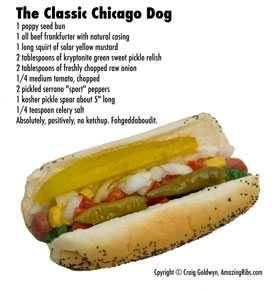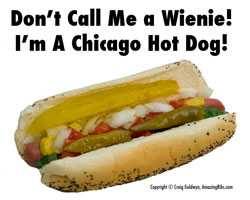In Chicago, where hot dog joints out number hamburger joints, there is one and only one classic recipe, and very little variation from it. It is the perfect hot dog.

Ask foodies around the world what makes the great city in the middle of America famous and they will reply Charlie Trotter’s, Topolobampo, Everest, or one of the other temples of the table. Ask tourists what culinary wonder starts them salivating and they’ll say deep dish pizza. But ask the “Grabowskis” as Da Coach Mike Ditka calls hard working lunch pail Chicagoans, and they will tell you it is the Chicago Hot Dog.
Here’s proof. In 2005, The Chicago Tribune polled its readers to determine the “7 Wonders of Chicago.” Predictably the top 10 were the magnificent Lake Michigan lakefront, Wrigley Field, the “El” elevated trains, the Sears Tower, the 1869 Water Tower, the University of Chicago, the Museum of Science and Industry, the Chicago River, Millennium Park, and Chicago Blues. In 11th place was the Chicago Hot Dog. Pizza didn’t even make the list. The Chicago Hot Dog is so popular the newspaper estimates there are 1,800 hot dog stands in the area, far more than all the McDonald’s, Burger Kings, and Wendy’s combined. To see my favorite Chicago Hot Dog stands, click here.
What makes the Chicago Hot Dog special? Like Chicago’s famous architecture, it is great design. It is a juicy, crunchy, sloppy combo that leaves your fingers fragrant for hours: A garlicy all-beef frankfurter, usually Vienna Beef brand, with a natural casing, simmered in hot water, never boiled, on a Rosen’s bun studded with poppy seeds and topped with solar yellow mustard, sweet kryptonite green pickle relish, pungent chopped onion, juicy tomato slices, spicy hot “sport” peppers, a salty crunchy kosher pickle spear, and a sprinkle of magic dust: celery salt. The result is a sandwich with so much vegetation that it is called a “garden on a bun”. This is the recipe that is served at practically all hot dog stands in Chicago.
It makes sense. In the 1800s meat packers such as Armour, Swift, and Oscar Mayer grew up on the Southside. There were enough slaughterhouses that Chicago was dubbed “hog butcher for the world” by poet laureate Carl Sandburg. At the same time, Chicago is built on such rich black soil that if you spit on it a human being will sprout, hence the city’s official motto “Urbs in Horto”, City in a Garden.
Many of the immigrants who settled in Chicago and worked in the stockyards were farmers back home and they planted vegetable gardens behind their homes in Chicago. The Chicago Hot Dog was the inevitable confluence of flesh and verdure. Perhaps the city’s motto should be changed to “Hortus in Pane.”
Nobody knows for sure where the recipe started, but here’s one credible story: Located in the great outdoor Jewish Maxwell Street Market, Fluky’s was opened on the northwest corner of Maxwell and Halsted about the same time the stock market crashed in 1929 by Abe “Fluky” Drexler when he was only 18 years old. The rickety wooden shack with no refrigeration and a fire hydrant for water became known for its “Depression Sandwich,” a complete meal for the laborer, a hot dog with mustard, relish, onion, pickles, pepper, lettuce, tomatoes, and fries for only a nickel.
The customary method for cooking dogs in Chicago is called the “dirty water” method. The dogs are simmered, not boiled, in water for 10 minutes. This makes them turgid and juicy, firm but not rubbery. After simmering scores of dogs in the same water all day the water is rich in flavor. The goal is to cook the meat through without cracking the skins.
Another technique is to steam them for 15 minutes. Steaming leaves the meat more piquant than simmering, with a nice snappy skin.
Some vendors roll them around on a hot dog rotisserie, hot stainless steel tubes that keep the dog rolling in its sleep on a perpetual motion conveyor belt to gustatory perfection. This makes a tastier dog than simmering or steaming, with a crisper skin, but they are not as moist and puffy. The problem is that sometimes they sit on these rollers all day and precious fluids begin to drip off.
Personally, I am among the minority who prefer what the locals call “char dogs,” cooked over an open flame, to the dirty water dog. The dry heat keeps them crisp and keeps all the juices inside where they belong. It also browns the skins creating sweetness that chefs call “caramelization” or the “Maillard reaction.” This also amps up the garlic and paprika. They don’t plump up as much and they are a bit less juicy, but the added richness stands up better to all the condiments we pile onto a hot dog in Chicago. Voicing such a preference will guarantee that I am ostracized by the purists in Chicago. So be it.
Hot dog Zen
So the Buddhist monk arrives at Midway Airport in Chicago, walks up to the Superdawg stand and says “Make me one with everything.” The vendor wonders how often the monk says this, shrugs, loads up a bun with all the classic fixins, and hands it to him. The monk hands him a $20 bill (17.24 euros). The vendor puts the bill in the cash drawer and closes the drawer. “Change?” asks the monk. The vendor smiles and responds: “Change must come from within.”
Posters, T-shirts, & more

You can order a poster, refrigerator magnets, clocks, postcards, T-shirts, hats and other apparel of the Classic Chicago Hot Dog from my storefront at CafePress.com. You can order poster sized enlargements here.

Makes:
Takes:
Ingredients
- 1 bun length jumbo all beef frankfurter with a natural casing
- 1 poppy seed bun
- 1 long squirt of yellow mustard
- 2 tablespoons sweet pickle relish
- 1 small white Spanish onion
- 1/4 medium Roma tomatoes
- 2 pickled sport peppers
- 1 kosher pickle spear or fresh cucumber spear, about 5" (12.7 cm) long
- 1/4 teaspoon celery salt
These recipes were created in US Customary measurements and the conversion to metric is being done by calculations. They should be accurate, but it is possible there could be an error. If you find one, please let us know in the comments at the bottom of the page
Method
- Prep. Cut the stem off the end of the tomato and squeeze it over the trash can ejecting the seeds. Chop the tomato into 1/4" (6.4 mm) chunks. Dice the onion.
- Cook. For the classic dirty water dog, bring enough water to cover the dog to a boil, then cut back to a simmer. Simmer, never boil, the dog for 10 minutes.
- For a char dog, use a technique I learned from Gold Coast Dogs. Cut an X shape in the ends of the dog. When they cook they will curl up and get extra crispy. Cook the dogs over a medium high grill until the skin darkens and there are nice grill marks all around.
- Traditional Chicago Hot Dog buns are steamed. Click here for tips on how to prepare your buns.
- Serve. To serve a Chicago dog, begin by placing the frankfurter on the bun. Squirt the mustard on the dog on one side between the meat and the bun. Spread the relish between the meat and the bun on the opposite side of the mustard. Sprinkle the chopped onions on top of the mustard. Distribute the tomato chunks all around. Place the peppers on top of the tomatoes. Place the spear on top of the onions and mustard. Sprinkle the celery salt on top of the vegetation. Absolutely, positively, no ketchup. Fohgeddaboudit. Now serve and enjoy.




High quality websites are expensive to run. If you help us, we’ll pay you back bigtime with an ad-free experience and a lot of freebies!
Millions come to AmazingRibs.com every month for high quality tested recipes, tips on technique, science, mythbusting, product reviews, and inspiration. But it is expensive to run a website with more than 2,000 pages and we don’t have a big corporate partner to subsidize us.
Our most important source of sustenance is people who join our Pitmaster Club. But please don’t think of it as a donation. Members get MANY great benefits. We block all third-party ads, we give members free ebooks, magazines, interviews, webinars, more recipes, a monthly sweepstakes with prizes worth up to $2,000, discounts on products, and best of all a community of like-minded cooks free of flame wars. Click below to see all the benefits, take a free 30 day trial, and help keep this site alive.
Post comments and questions below
1) Please try the search box at the top of every page before you ask for help.
2) Try to post your question to the appropriate page.
3) Tell us everything we need to know to help such as the type of cooker and thermometer. Dial thermometers are often off by as much as 50°F so if you are not using a good digital thermometer we probably can’t help you with time and temp questions. Please read this article about thermometers.
4) If you are a member of the Pitmaster Club, your comments login is probably different.
5) Posts with links in them may not appear immediately.
Moderators